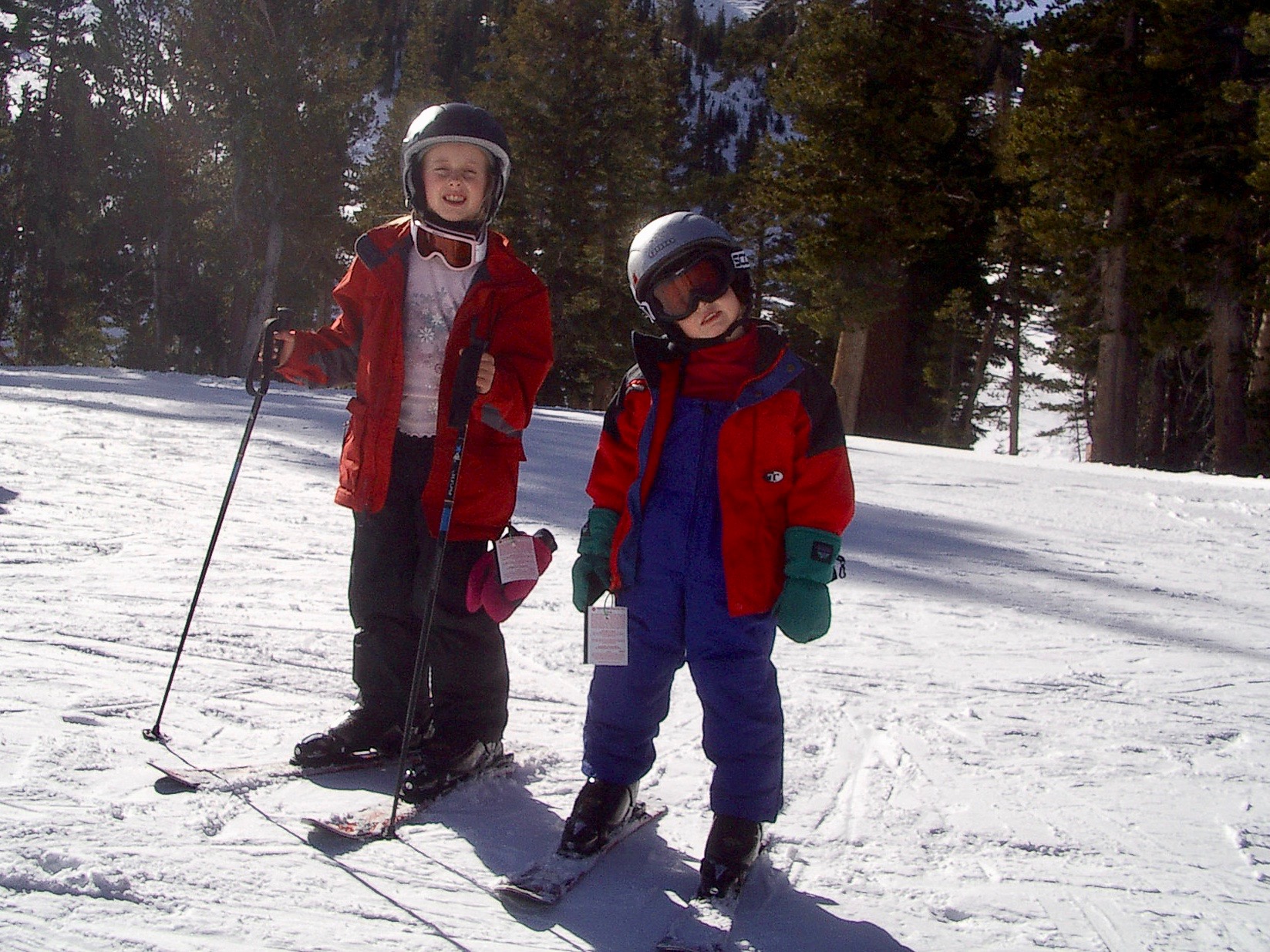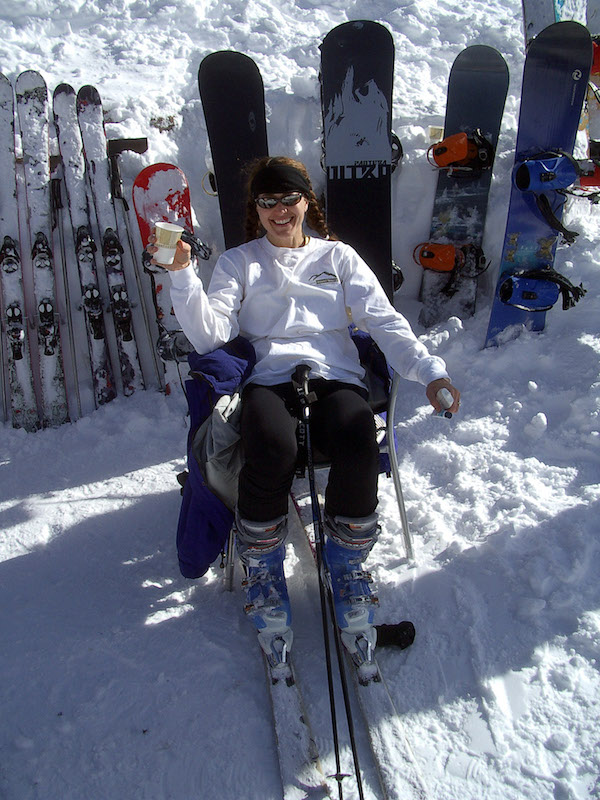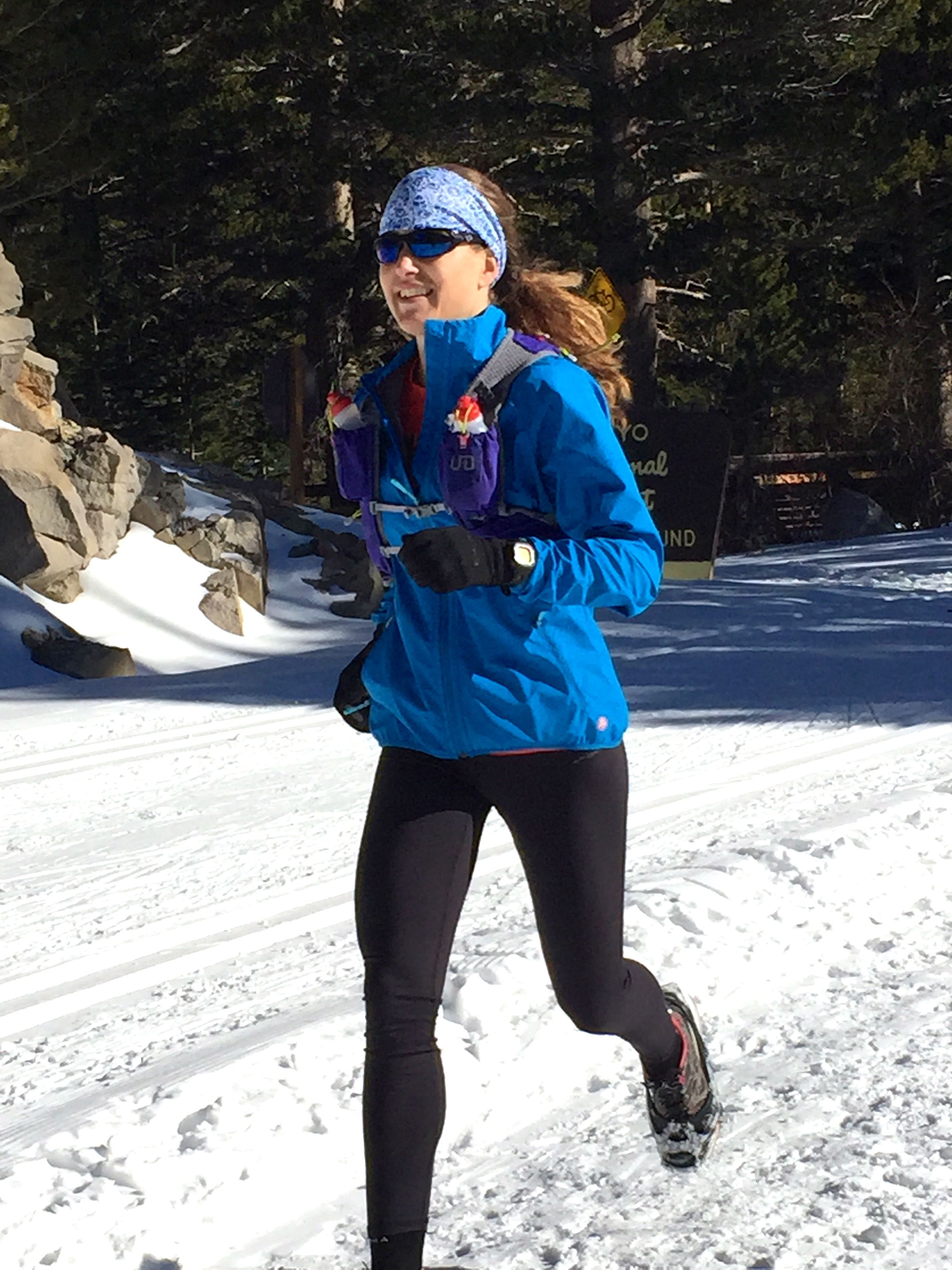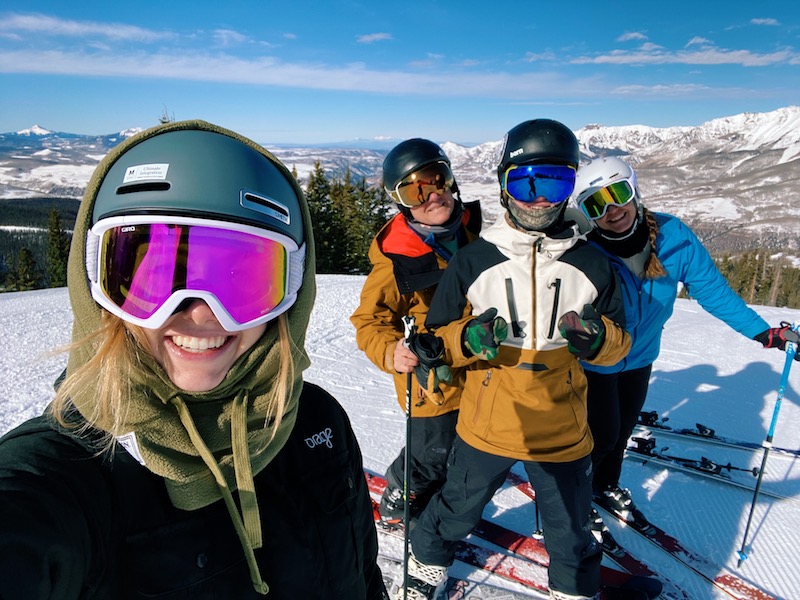Alpine skiing still feels more like an amusement park ride than a sport. Sitting on a chair lift, I’m reminded of how it feels to ride a rollercoaster slowly up while the anticipation of the downward plunge makes my chest tighten and heart thump. No matter how many times I get on a lift—holding my breath as the empty seat whips around the turn and scoops me up in a sickening bobbing motion—I remain on high alert as I sit on a swaying bench suspended in the sky, one hand always clutching the armrest or hooked over the seat back so I won’t slide and fall several hundred feet.
This season, which is my first winter living full time in Telluride, I’ve skied nine times so far. Riding up or skiing down, I tell myself to relax and take in the views of snow-dusted mountain ridges and snow-clumped tree branches, yet I can almost feel my glands releasing adrenalin. Nothing about skiing feels normal, natural or graceful, not yet, and I’m starting to wonder if it ever will.
From the moment I enter the ski locker area to don my gear, I adopt a combat-ready seriousness for the challenges ahead, starting with the inevitable battle with my expensive new Nordica boots. The process of coaxing my foot through the unforgiving right-angle tunnel gives me a hot flash under my wool base layer, and I grunt audibly while visualizing an infant’s shoulders getting lodged in the birth canal. As someone who suffers claustrophobia when peeling off tight skinny jeans, frantically shaking my feet to get the fabric unstuck from my ankles, I can barely keep from losing my shit and screaming out loud as I put on my boots. But I get them on, and then I shoulder my skis, grab my poles and clomp up a metal stairway to the base of the first lift while my thick bell-bottom ski pants swish-swish.
When I skied with my two kids and husband a couple of days before Christmas and we approached the front of a lift line together, I barked at my family, “Wait, move over, let me be on the side so I have something to hold onto.”
“Oh my God, Mom!” my son Kyle said while gaping at me as if I were unrecognizable, a scaredy-cat inhabiting his normally adventurous mother.
When the lift finally reaches the top, and the little yellow “unload here” signs beckon, I brace myself to stand up and ski forward at the correct moment, but I picture myself chickening out or getting stuck and doomed to ride the chair back down.
The dismount always went as planned until a few days ago, when the area at the top of a run loomed as an icy lip rather than a smooth ramp of snow. When I stood up and used one hand to push my butt out of the chair, my skis pivoted and slipped on the ice, tipping me over like a domino. The operator stopped the lift, forcing hundreds behind me to wait as I rolled around like a beetle on its back. Finally, after seconds that felt like minutes, I got my skis under me and stood back up. I’m amazed that this toppling over doesn’t happen every single time I dismount a lift, and now I have renewed expectation that it will.
For the past six weeks, I’ve persisted in re-learning this sport that scares me. I am somebody who’s been called “badass” as a compliment because of the ultramarathons over mountains and across deserts that I conquer. I can go up and over scree-covered summits in summertime hailstorms. I can gallop bareback on a horse across an open field, and I’ll do as many burpees and thrusters as almost anyone in the gym. But that boldness and strength evaporate when I attempt downhill skiing.
I am in awe of the 80 percent of the skiers on the hill who are better than I, who ski with picture-perfect form over snowy bumps or who drop into a powdery forest on a steep slope to ski through trees and to jump over exposed rocks, which to me seems suicidal.
But I am determined to get better and be more than a slow intermediate skier who only feels capable on groomed wide runs. I’m determined to stop sticking my butt out too much and letting my skis drift too far apart. I want to look and feel like I know what I’m doing, and I want to get good enough to enjoy rather than fear the steepness and speed.
I also want to be a part of this community. Skiing is woven into Telluride’s culture, economy and history. “If you live here, you have to ski,” I heard more than once after we moved here year-round last May and I confessed to local acquaintances that I knew Telluride only in summer and fall, being a Californian in winters.
I won’t feel like a real local or a real Coloradoan until I can look at the finger-like ski runs that come into view while driving from home to town and be able to name them and say, “I skied down that.”
An image I carry of the archetypal cool Colorado chick springs from a poster that hung in the bathroom of my parents’ cabin on Last Dollar Road near Telluride, where I spent every childhood summer. The poster, from the 1970s, pictured a woman with long, straight brunette hair who looked kind of like Lindsay Wagner of The Bionic Woman. She was dressed head to toe in ski gear—pom-pom knit hat, puffy down jacket, waterproof pants and bulky ski boots attached to skis—but strangely, she was photographed sitting on a toilet, with her pants down, in a wildflower-filled meadow in a high-alpine basin. The poster’s caption read, “Ski the Rockies, We Have the Runs.”
The image made no sense—why was a toilet out in the open on a mountain? why was she dressed to ski when grass, not snow, covered the ground?—but I used to gaze at that poster, while I myself sat on a toilet, and think about how I would like to be like her.
My family never introduced me to skiing, however. It took dating Morgan to discover skiing and then to develop the self-fulfilling self-image that I’m not good at it.
Morgan and his family invited me to their condo in Mammoth Lakes the week after Christmas 1985, when I was 16. Morgan and I had been together for about a year. He and his brother grew up skiing, and his parents and grandparents had been regulars at Mammoth ever since the days of rope tows. I didn’t even own a pair of mittens.
On the first morning we skied, I felt highly self-conscious that my legs looked inflated because I had to borrow too-big snow pants from Morgan’s mother. Then I had to navigate a chaotic rental procedure that left me hobbling in heavy boots. Already fatigued by the time I stepped outside with all the gear, I clipped on the skis and joined a half-day group lesson for first-timers. I followed the leader to get down the bunny hill with skis pointed together, my arms hanging uselessly while dragging poles at my side.
After a lunch break, Morgan suggested that we try Mammoth’s shortest and easiest intermediate run together. I guess it was fair to assume that one lesson had taught me the basics of how to ski. But very little from the morning session stuck in my brain.
On the unfamiliar intermediate slope, I picked up velocity and began to head diagonally toward a plastic webbed orange barrier that defined the edge of the run. I stared at that orange fence the way a driver must stare at approaching headlights before impact, knowing the outcome but helpless to prevent it. When I collided with the barrier, one ski went through a hole in the plastic fencing and ripped it off a stake. The other ski popped off and disappeared. I came to a stop on my back, leg tangled in the material. I felt like a fish in a net after it gives up flopping. I was so embarrassed that I wanted to quit and never return.
But I did return, about once a year after Morgan and I got married, because the Eastern Sierra is so beautiful and my in-laws’ condo so convenient. We put the kids in ski school. I dutifully rented gear, not wanting to invest in my own equipment because I skied so infrequently.
I graduated to blue intermediate slopes, but I never got good enough to enjoy it and to feel it was worth the hassle and expense.

My kids in Mammoth in 2007. Meanwhile …

… this is me on that same day in 2007. I took a lot of breaks while skiing during those early days.
Sometime around winter 2008, I decided I’d had enough. No more spending money on a lift ticket, no more bothering with rentals—it seemed clear to me that running in the snow (aided by traction devices) or going to the gym were preferable to skiing. For the next decade, my husband and kids skied without me while I spent the day working out or relaxing on my own.
At some point during those years, “I don’t ski”—my reply when people asked about it—internally became “I can’t ski.”

Me running in Mammoth several years ago, after I boycotted skiing.
Throughout those years, I would come to know and love Telluride’s trails and peaks as I hiked and ran. Traversing Telluride’s ski area in summertime with my leg power and minimal gear hardened my view that I was meant to run, not ski.
Then we moved here permanently, and I decided I had to start over and give skiing my best try. I could have dismissed the sport as an unnecessary luxury and continued to snub the overpriced scene at the ersatz Mountain Village (the ski resort above Telluride), but I felt a genuine desire to get to know these mountains the locals’ way in wintertime. I also felt some remorse about being the odd-person-out in our family foursome. But was I too late in life to get with it?
I went all in: I bought a season pass and all the necessary gear, much of it used for a good deal, and we rented a locker. I succumbed to a helmet and goggles even though they make my head look like a giant bug. (Many skiers didn’t wear helmets back in the days when I briefly skied, so I was used to a helmet-free head and regular sunglasses on my eyes.)

Got gear
On Day One, I set the bar low, my only goal being to remember how to get on and off the lift and then to ski down a beginner run called Village Express. I looked and felt awkward, but I did it. On Day Two, I took a lesson, which was moderately helpful at teaching me what I should be doing—things like getting my weight forward and tilting my ankles side to side—but the lesson didn’t actually get me to do what good skiers do.
On all the other ski days through December and early January, I kept going up and down various intermediate blue runs with a resoluteness and faith that eventually I would get better.
Here are a couple of short clips showing my unexceptional form with a lot of room for improvement:
When I skied with my daughter and son during their winter break from college, their speed and balance astonished me. How had I not known that my two kids had become so accomplished and such daredevils? I realized with a pang of regret that I had been missing in action while my children—now young adults—steadily improved at something that had nothing to do with me.
Whereas I tend to twist my torso and slow down on every serpentine curve, Colly, 21, fearlessly flies down the hills far ahead of even Morgan, her body and skis perfectly stacked as she carves small turns. Kyle, 18, shreds the gnar and soars over jumps on his snowboard. Both kids sometimes follow intrepid friends down double-black-diamond runs through powder, over bumps and around trees.
Here’s a clip of Kyle:
My kids encourage me to ski, seeming happy to have me along and no doubt feeling some satisfaction at being far superior to their know-it-all mother who believed she was the better athlete. I hope my family understands and respects on some level that I’m trying valiantly not only to learn this sport at the ripe age of 50, but also to make up for lost time with them.

Colly’s selfie of our foursome, taken a few days before Christmas, showing I’m no longer missing in action.
I hope I’m showing my kids by example that there is an upside to feeling barely average, humbled and scared by something—and then trying to improve rather than quit.
Taking a seat on a chair lift and committing to ski down a snow-covered mountainside is my way of stepping out of the proverbial comfort zone, much more so than spending half a day or longer running an ultramarathon. It has become a way for me to stoke courage, shrug off age, earn achievement and maybe one day soon, have some fun.
Skiing also is a way for me to recognize, and then release, self-consciousness about how I perform compared to others and how others view me. I try to soften the critical ways I view myself skiing (“dork,” “newb,” “old lady” being some of the labels that cross my mind).
I hope I’m showing my children that I try to live out my favorite Eleanor Roosevelt quote, and they can, too: “You gain strength, courage and confidence by every experience in which you really stop to look fear in the face. … You must do the thing you think you cannot do.”
Last weekend, when Morgan and I skied together, I achieved the first significant breakthrough in progress since I started skiing this winter. While riding Chair 6 to get to the top of See Forever, an intermediate run, we surveyed the top of Woozley’s Way, a double-blue-square run signaling advanced intermediate. He told me I could do it, but the pitch of the slope and its crusty surface intimidated me.
We skied over to Woozley’s Way, and I paused while perched at the top, debating my next move. Too steep, too narrow I told myself, before another voice argued in my head, “You actually can do this—you just don’t want to.” I can do this, I said. Nothing ventured, nothing gained.
After that mental buildup, the pedestrian execution felt a bit anticlimactic. I carved slow turns and then skied faster with skis more parallel when the slope became more mild.
“What other runs are double-blues?” I asked Morgan with a trace of eagerness. We looked at the map and realized I could go up Chair 9 and ski Lookout, a double-blue that bypasses the black-diamond runs.
Chair 9, an old-style triple lift on the front side of the mountain, is a local’s favorite. The chair takes skiers to the top of The Plunge, the signature black-diamond run that plunges toward town and dates back to the resort’s early days. I’d heard about The Plunge ever since I was a kid.
At the top of Chair 9, Morgan and I went separate ways so he could ski The Plunge while I went down Lookout. Woozley’s Way had bolstered my confidence. Alone on the slope, I leaned forward and let myself glide downhill with my skis parallel and neutral for a split second longer than usual before I tilted my ankles and edged into the hill to check my speed. I pictured my daughter’s speed and form and tried to emulate her.
I skied that run with a nascent feeling of tingly satisfaction that made me flash back to the time I ran at full effort down a nearby ski slope in the final miles of 2016’s Telluride Mountain Run ultra, flowing like a raging river to keep from getting passed and to win my age group.
I met Morgan at the base of Chair 9. “Want to do it again?” he asked, to which I said, “Sure!”
As we rode up, I surveyed The Plunge, wondering if I could handle it—at least the groomed top portion. “I’d like to try that by spring,” I said.

Oh, so familiar! I also started skiing as an adult, even though I went to college in VT where it seemed like everyone skied. It’s not an easy sport to just jump in to—it’s a commitment financially and mentally. When we purchased a home in Stowe, VT I had to commit. We tell our boys (now 21, 19, 16) that it was a gift and privilege to learn to ski at 3. They are all passionate, graceful and fearless skiers. Somehow there seems to be no catching up for me as hard as I try. That effortless flow I attempt to mimic when they slow down enough for me to follow feels stiff and forced. They occasionally give me some drills to practice which surprisingly make a difference, so there is hope! I still have that lingering fear when we head to the mountain and would probably still prefer to strap on my xcountry skis, but I don’t want to miss the group fun and the apres😀 I do think my ego is half the problem evidenced by the fact that I avoid the runs under the lift. People assume I’m an expert skier since we do spend almost every weekend skiing and if I can run for hours I must be a natural athlete, right? Sarah, you seem to be progressing fast and have the right attitude for success. I’m going to take some inspiration from your courage to face your fears. One tip that I can take from trail running and also translate to mountain biking and skiing is look ahead on the trail to your next turn, not at your feet. BTW, Telluride is my favorite skiing destination-enjoy every minute of it.
Love this story, Sarah! I love how you continually push yourself to achieve greater things! Always believing, always improving. You are a rockstar, on the trails, in the gym and on the slopes! Go get it!
Great story, Sarah, and it echoed my experience when I was about your age and we moved to Carbondale, Co. I don’t think Matt will ever recover from the embarrassment of his Mom deciding not to get off the lift and then crashing in a heap when the operator yelled.”Jump.” Keep up the skiing. Colorado gave winter a whole new life for me.
Sue
I still don’t own helmet and goggles. Old school does hard.